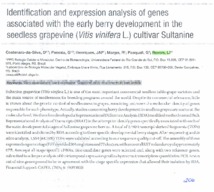Identification and expression analysis of genes associated with the early berry development in the seedless grapevine (Vitis vinifera L.) cultivar Sultanine.
Identification and expression analysis of genes associated with the early berry development in the seedless grapevine (Vitis vinifera L.) cultivar Sultanine.
Autoria: COSTENARO-DA-SILVA, D.; PASSAIA, G.; HENRIQUES, J. A. P.; MARGIS, R.; PASQUALI, G.; REVERS, L. F.
Resumo: Sultanine grapevine (Vitis vinifera L.) is one of the most important commercial seedless table-grape varieties and the main source of seedlessness for breeding programs around the world. Despite its commercial relevance, little is known about the genetic control of seedlessness in grapes, remaining unknown the molecular identity of genes responsible for such phenotype. Actually, studies concerning berry development in seedless grapes are scarce at the molecular level. We therefore developed a representational difference analysis (RDA) modified method named Bulk Representational Analysis of Transcripts (BRAT) in the attempt to identify genes specifically associated with each of the main developmental stages of Sultanine grapevine berries. A total of 2400 transcript-derived fragments (TDFs) were identified and cloned by RDA according to three specific developmental berry stages. After sequencing and in silico analysis, 1554 (64.75%) TDFs were validated according to our sequence quality cut-off. The assembly of these expressed sequence tags (ESTs) yielded 504 singletons and 77 clusters, with an overall EST redundancy of approximately 67%. Amongst all stage-specific cDNAs, nine candidate genes were selected and, along with two reference genes, submitted to a deeper analysis of their temporal expression profiles by reverse transcription-quantitative PCR. Seven out of nine genes proved to be in agreement with the stage-specific expression that allowed their isolation by RDA.
Ano de publicação: 2010
Tipo de publicação: Resumo em anais e proceedings
Unidade: Embrapa Uva e Vinho
Observações
1 - Por padrão são exibidas publicações dos últimos 20 anos. Para encontrar publicações mais antigas, configure o filtro ano de publicação, colocando o ano a partir do qual você deseja encontrar publicações. O filtro está na coluna da esquerda na busca acima.
2 - Para ler algumas publicações da Embrapa (apenas as que estão em formato ePub), é necessário ter, no celular ou computador, um desses softwares gratuitos. Sistemas Android: Google Play Livros; IOS: iBooks; Windows e Linux: software Calibre.
Acesse outras publicações
Acesse a Base de Dados da Pesquisa Agropecuária (BDPA) para consultar o acervo completo das bibliotecas da Embrapa.

